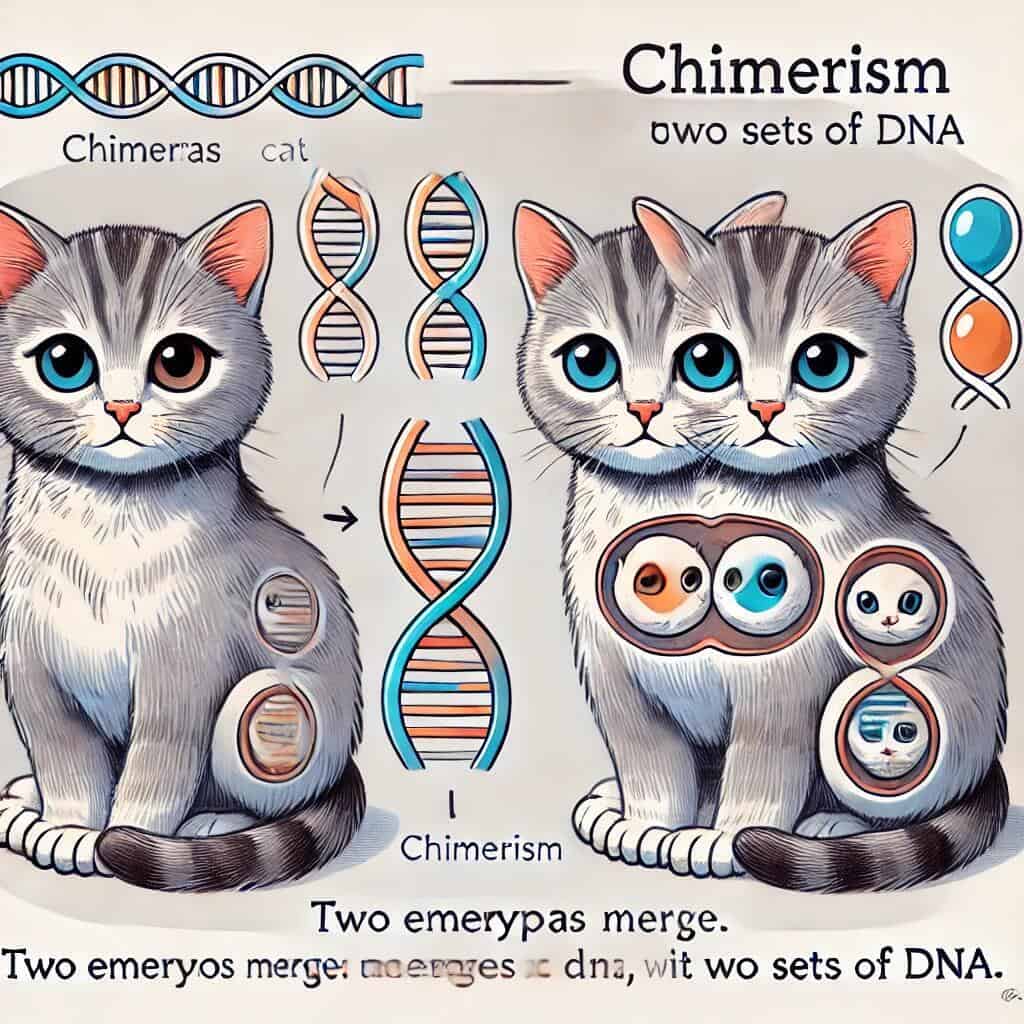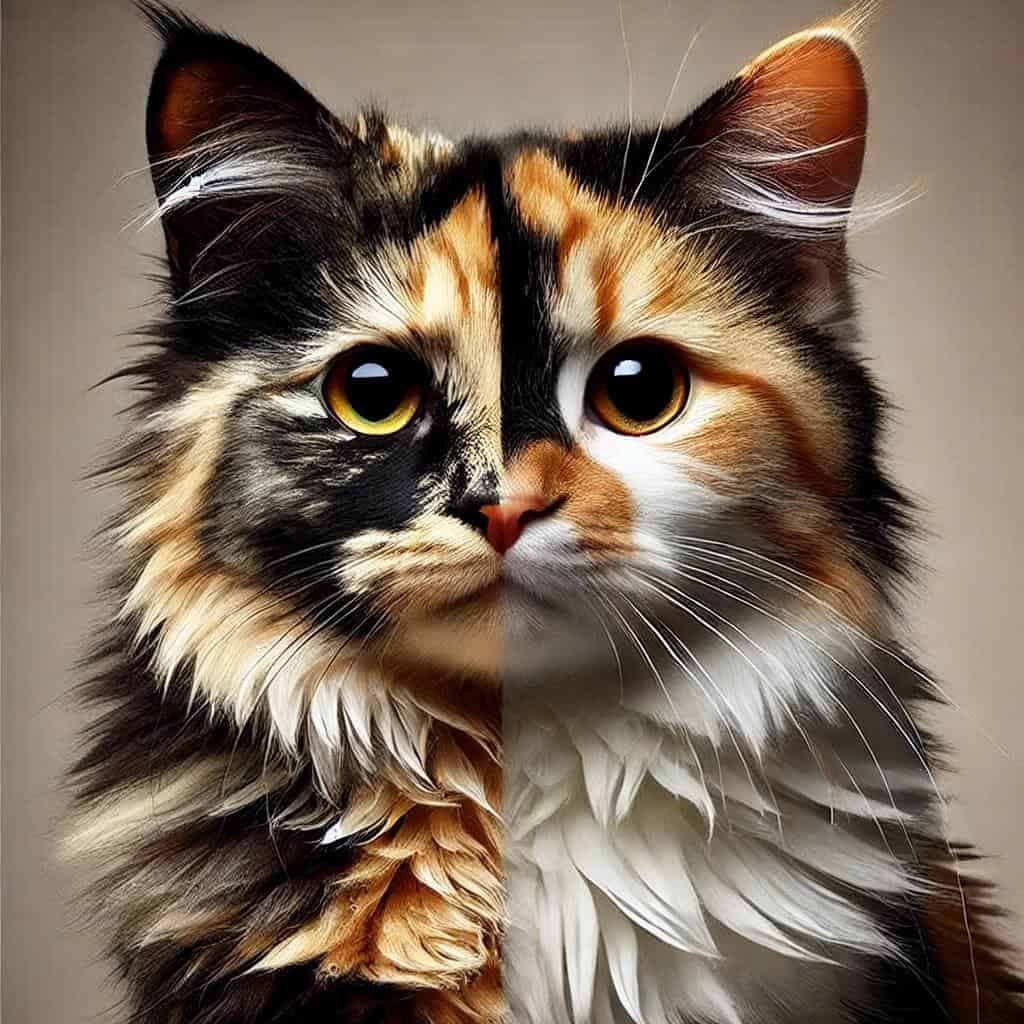Introduction:
Among the many fascinating cats in the world, few are as captivating and mysterious as the chimera cat. With its distinct two-toned face and unique fur patterns, the chimera cat is a rare genetic marvel that has sparked interest and curiosity among cat enthusiasts. But what exactly is a chimera cat? How do they get their distinct appearance, and are they different from other cats like Calico and Tortoiseshell cats? In this guide, we’ll explore the intriguing world of chimera cats, answering all your burning questions about their genetics, characteristics, costs, and health.

- What is a Chimera Cat?
- The Chimera Cat Pattern
- Is a Chimera Cat Rare?
- Why Does the Chimera Cat Look This Way?
- Why is Chimerism More Common in Cats?
- Do Chimera Cats Have Different Colored Eyes?
- Are Chimera Cats the Same as Calico and Tortoiseshell Cats?
- What are a Chimera Cat’s Characteristics?
- How Much Does a Chimera Kitten Cost?
- Do Chimera Cats Have Health Issues?
- Conclusion
What is a Chimera Cat?
A chimera cat is a feline whose cells contain two different sets of DNA. This phenomenon, known as chimerism, occurs when two embryos merge early during a cat’s development, forming one organism with two distinct genetic codes. The result is a cat with two sets of DNA, which can often be seen in its striking physical characteristics, such as a split-colored face or patchwork fur patterns.
Unlike other cats that inherit DNA from two parents, chimera cats have genetic material from what would have been their “twin.” This rare genetic event makes chimera cats stand out in both appearance and biological structure.
The Chimera Cat Pattern
The chimera pattern is a striking feature in these cats. Most often, it manifests in a sharp division of color on the face, where one half is a completely different color from the other. These cats can look like they are wearing two different “faces,” creating an awe-inspiring, almost mystical look.
The pattern is not limited to the face. Some chimera cats display a mosaic-like fur pattern across their bodies, where different parts of the body show distinct color patches. One famous example is Venus the two-faced cat, known for her dramatic half-black, half-orange face with mismatched eyes.
Is a Chimera Cat Rare?
Yes, chimera cats are rare, but they may not be as rare as their striking appearance suggests. Chimerism is a genetic anomaly, and while it is not common, it’s believed that more chimera cats exist than are visibly recognized. Many cats may have two sets of DNA but do not display the characteristic two-tone fur pattern, making them less noticeable.
The visible chimera pattern is highly unusual and often makes these cats particularly valuable in the pet world. Still, due to the subtle nature of genetic chimerism, it’s likely that many chimera cats go unrecognized without genetic testing.
Why Does the Chimera Cat Look This Way?
The distinctive appearance of chimera cats is the result of their mixed DNA. During the cat’s development, two fertilized embryos merge into one organism, causing different sets of genetic information to be expressed in different parts of the cat’s body. This leads to the sharp color divisions on their fur, most often seen in the face.
In essence, a chimera cat is a combination of two potential cats in one, and their appearance reflects this fascinating genetic blending. Chimerism allows for a display of both genetic codes, sometimes resulting in a cat that looks like it is made up of two entirely different animals.

Why is Chimerism More Common in Cats?
Chimerism is more visible in cats compared to other animals because of how their fur color genetics work. Cats have a complex coat color genetic system, especially in females, which carry two X chromosomes. This allows for a more noticeable split in color when chimerism occurs.
Moreover, cats like Calicos and Tortoiseshells already carry genes for multiple coat colors, making it more likely that chimerism will produce visible differences in color. This, combined with the X-inactivation process that randomly silences one of the X chromosomes in each cell, makes chimerism more noticeable in cats.
Do Chimera Cats Have Different Colored Eyes?
Some chimera cats do indeed have heterochromia, or two different colored eyes. This is because the genetic material from two embryos may contain different genes for eye color. As a result, one eye might be blue, while the other could be green, yellow, or amber.
This trait is not unique to chimera cats but is more common in them due to the dual sets of DNA they possess. Heterochromia adds to the mesmerizing and rare appearance of these fascinating felines.
Are Chimera Cats the Same as Calico and Tortoiseshell Cats?
While chimera cats can resemble Calico and Tortoiseshell cats, they are genetically different. Calico and Tortoiseshell cats have a distinct coat pattern due to the random inactivation of one of the X chromosomes, which carries the gene for coat color. This leads to a blend of orange, black, and white patches in their fur.
In contrast, chimera cats have two different sets of DNA, meaning their unique patterns are the result of two completely distinct genetic codes blending together. While a chimera cat may have a Calico or Tortoiseshell pattern, they are genetically distinct from a typical Calico or Tortoiseshell cat.

What are a Chimera Cat’s Characteristics?
The most defining characteristics of a chimera cat are its unusual fur pattern and potential heterochromia (two different colored eyes). These cats often have a split-colored face, with a sharp division between colors on each side. Additionally, their fur may display a patchwork of contrasting colors, depending on how the two sets of DNA are expressed.
Beyond their physical appearance, chimera cats behave like any other domestic cat. They are known for being affectionate, playful, and independent, much like their non-chimera counterparts.
How Much Does a Chimera Kitten Cost?
The cost of a chimera kitten can vary depending on factors such as rarity, breeder, and location. On average, chimera kittens can range from $1,000 to $5,000, with particularly striking or rare examples commanding even higher prices.
Because chimera cats are not a specific breed, they are often valued for their rarity and appearance rather than any particular pedigree. However, their unique genetic background makes them highly sought after among cat enthusiasts.
Do Chimera Cats Have Health Issues?
In general, chimera cats are no more prone to health problems than other domestic cats. Their dual sets of DNA do not necessarily make them more susceptible to illnesses or genetic disorders. However, because they carry two distinct sets of genetic material, it is possible for them to inherit traits that could increase their risk for certain health conditions.
For example, if one of the two merged embryos carried a genetic predisposition to a specific illness, the cat might be at risk for that condition. That said, there is no evidence that chimerism itself causes any particular health problems in cats.

Conclusion
Chimera cats are truly a marvel of nature, representing one of the most visually captivating examples of genetic diversity in the animal kingdom. Their split-colored faces, mismatched eyes, and unique fur patterns make them stand out as rare and fascinating creatures. Whether you’re drawn to their striking appearance or intrigued by their genetic makeup, chimera cats offer a glimpse into the incredible complexity of feline genetics.
With no significant health issues tied to their chimerism and an array of breathtaking patterns, chimera cats are as healthy, playful, and affectionate as any other cat. If you ever come across a chimera kitten, you’ll not only have a rare pet but also a living example of genetic wonder.
Share your thoughts in the comments below! If you enjoyed this post, consider subscribing to our newsletter for more pet tips, stories and blogs!
